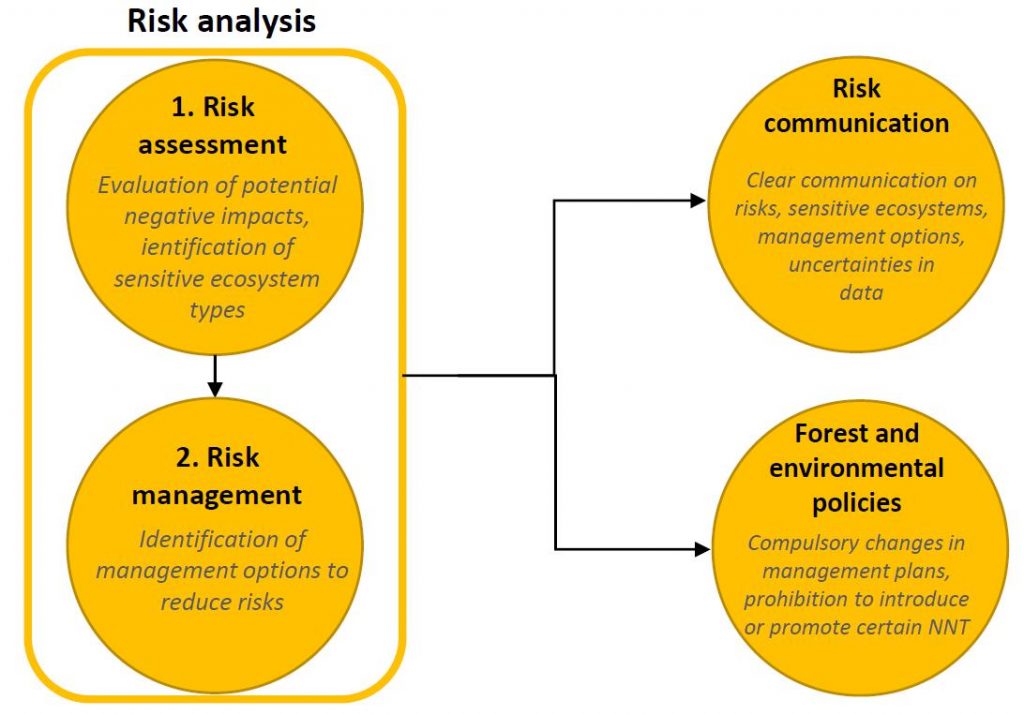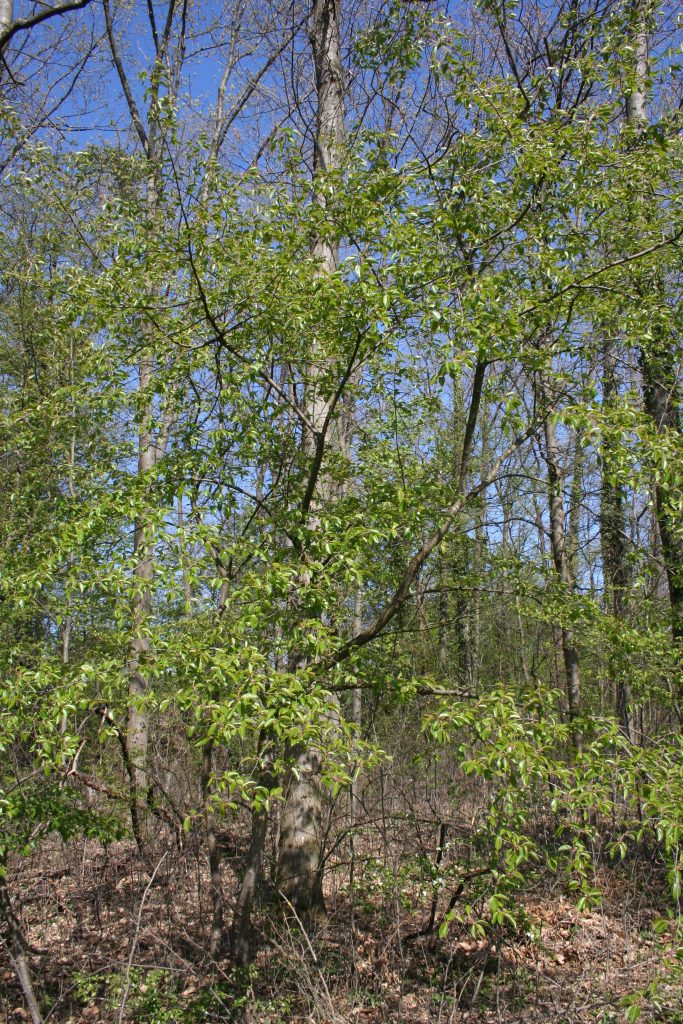As the different impacts mechanisms and examples of problematic NNT have shown in the previous sections, the risks of NNT strongly depend on the sites on which they occur or which are nearby, e.g. whether protected areas are found in the immediate vicinity, and which characteristics they have that (potentially) enable them to spread and establish quickly, for example.
Given the possible risks of NNT their use requires compromises that should be found on the basis of scientific knowledge and expertise. This means that the cultivation of NNT that pose low risks of becoming invasive may be accepted by nature conservation to a reasonable extent, just as nature conservation objectives should be taken into account by forestry. Therefore, the cultivation of NNT must be sustainable, i.e. any risks of NNT must be reduced and the occurrence and establishment of (potentially) invasive tree species must be avoided, limited, and removed where feasible.
In order to identify species with low risks that could be integrated into forest management, a formal assessment of the risks associated with a particular NNT is necessary.
A ‘risk assessment’ can defined as the evaluation of possible negative impacts associated with the introduction of a non-native species. Based on such assessments, management options are identified and implemented to reduce the risk of (potential) negative impacts; this process is formally referred to as ‘risk management’. Risk assessment and risk management, while two separate processes, form interacting parts of a risk analysis framework (Figure).
Experts typically conduct risk evaluations for specific species or taxa, taking into account all available evidence and knowledge. The risk assessment evaluations that arise are critical for supporting biodiversity management decisions and guiding environmental and forest policies. For example, evaluations may indicate that certain NNT that are expected to cause serious adverse effects that cannot be mitigated, prevented or reversed may no longer be cultivated. For example, policy makers could then make such recommendations mandatory for specific regions or ecosystem types.

Site-specific risk assessment of non-native tree species
Decisions about whether to tolerate, encourage, reduce or eradicate NNT should be site-specific. To help forest and conservation managers decide where NNT may (or may not) be planted, and which and how NNT can be used for sustainable forest management, risk assessments for NNT should be based on the following steps:
The goal of the risk assessment: Before conducting a risk assessment, the need and objectives for a risk assessment must be identified; this includes, for example, which area and which NNT should to be assessed.
1st Step – Definition of the risk assessment area
The boundaries of the risk assessment area must be clearly delineated, e.g. by providing a map of the respective region. For instance, the risk assessment area can comprise a country, region, or a small area, such as a national park. The larger the study area, the more elaborate and time-consuming the assessment can become. Conversely, the smaller the study area, the fewer ecosystem types can be considered.
2nd Step – Identification of the occurrence of NNT
Here it is necessary to determine if and where the NNT occurs in the risk assessment area; e.g. monitoring data, observations or personal communications from local experts can be used for this purpose.
3rd Step – Collation of existing knowledge on the risks posed by NNT
A comprehensive literature and data search should be conducted here with special focus on the NNT concerned. The review should therefore include any existing knowledge on the NNT, i.e., its distribution in the risk assessment area, ecology (e.g., dispersal and reproductive capacities), actual or potential impacts on biodiversity or other ecosystem services, and human health, as well as available management options for risk mitigation.
4th Step – Areas and species of high conservation value
A comprehensive literature and data search should be conducted here with special focus on protected areas and species that are actually or potentially threatened by the NNT concerned.
5th Step – Expanding the current level of knowledge
If knowledge gaps have been identified for the NNT in the assessment area based on the previous steps, new data should be collected where reasonable. For example, there may be gaps in knowledge regarding how far the seeds of an NNT can actually be dispersed. This knowledge is important to be able to prevent unwanted spread into protected areas.
6th Step – Impact potentials of NNT in different sites
The data collected in the previous steps should be used here to evaluate the potential or actual impacts of the NNT on the different sites or ecosystem types in the risk assessment area. The aim is to identify those sites that are considered to be particularly threatened by the NNT, for example because they are competitive and may displace native species.

7th Step – Management recommendations
Based on assessment outcomes of previous steps, management measures should be recommended to mitigate or prevent risks of the NNT concerned.For the recommendations, the impact potential should be considered taking into account the reproduction and spreading potential as well as the spatial distribution of the NNT across different ecosystems in the risk assessment area. It is important to always relate recommendations to the specific site.
For example, one recommendation might be that management approaches involve appropriate buffer zones (exclusion zones for planting) around sensitive ecosystem types and regular removal of unwanted regeneration in protected areas. This is the case in south-west Germany, where buffer zones of 300 m must be established for north American Douglas-fir (Pseudotsuga menziesii Mirb. Farnco) around certain protected forest sites in state forests.
For example, the use of NNT should be discontinued when it is no longer possible to reverse undesirable occurrences because the possible control options are ineffective, ecologically unacceptable, or not financially feasible. If a NNT has already established in a protected habitat, an obvious option would be to eradicate existing populations and restore the habitat after removal, but this is not always feasible. For example, north America black cherry (Prunus serotina Ehrh.) can regenerate via root suckers and basal shoots and it is therefore virtually impossible to eradicate populations on the long term.
8th Step – Conclusion of the risk assessment
The aim is to summarize the main findings of the conducted risk assessment. Here, it should be clearly communicated which NNT are currently not at risk of becoming invasive in the risk assessment area, which NNT could pose a risk in certain locations and should therefore be closely monitored and their spread controlled, and which species should no longer be cultivated because their risks are high and cannot be controlled.
References for further reading
- Bartz, R. and I. Kowarik 2019 Assessing the environmental impacts of invasive alien plants: a review of assessment approaches. NeoBiota 43: 69-99.
- Bindewald, A., Brundu, G., Schueler, S., Starfinger, U., Bauhus, J., Lapin, K. 2021 Site-specific risk assessment enables trade-off analysis of non-native tree species in European forests. Ecology and Evolution, doi: 10.1002/ece3.8407
- Branquart, E., et al. 2016 From impact studies to management actions: practicing risk analysis of introduced trees Introduced tree species to European forests. F. Krumm and L. Vitcova. Freiburg, Germany, European Forest Institute: 114-135.
- Brundu, G., et al. 2020 Global guidelines for the sustainable use of non-native trees to prevent tree invasions and mitigate their negative impacts. NeoBiota 61: 65-116.
- Gossner, M. 2016 Introduced tree species in central Europe – consequences for arthropod communities and species interactions. In Introduced tree species in European forests: opportunities and challenges. F. Krumm and L. Vitcova (eds.), European Forest Institute, Freiburg, pp. 264-287.
- Kowarik, I. 2010 Biologische Invasionen: Neophyten und Neozoen in Mitteleuropa. Verlag Eugen Ulmer: Stuttgart, Germany, 492 p.
- Pötzelsberger, E., et al. 2020 Growing Non-native Trees in European Forests Brings Benefits and Opportunities but Also Has Its Risks and Limits. Current Forestry Reports 6: 339–353.
- Vor, T., Spellmann, H., Bolte, A. and Ammer, C. 2015 Potenziale und Risiken eingeführter Baumarten Baumartenportaits mit naturschutzfachlicher Bewertung. Universitätsverlag: Göttingen, Germany, 296 p.

